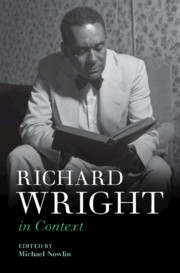Book contents
- Richard Wright in Context
- Richard Wright in Context
- Copyright page
- Contents
- Figures
- Contributors
- Abbreviations
- Richard Wright’s Works: A Chronology
- Introduction Richard Wright’s Luck
- Part I Life and Career, Times and Places
- Chapter 1 Richard Wright’s Triangulated South
- Chapter 2 Richard Wright’s Chicago
- Chapter 3 New York and Brooklyn
- Chapter 4 Paris and Ailly
- Chapter 5 Globetrotting, 1949–1960
- Part II Social and Cultural Contexts
- Part III Literary and Intellectual Contexts
- Part IV Reputation and Critical Reception
- Index
Chapter 3 - New York and Brooklyn
from Part I - Life and Career, Times and Places
Published online by Cambridge University Press: 08 July 2021
- Richard Wright in Context
- Richard Wright in Context
- Copyright page
- Contents
- Figures
- Contributors
- Abbreviations
- Richard Wright’s Works: A Chronology
- Introduction Richard Wright’s Luck
- Part I Life and Career, Times and Places
- Chapter 1 Richard Wright’s Triangulated South
- Chapter 2 Richard Wright’s Chicago
- Chapter 3 New York and Brooklyn
- Chapter 4 Paris and Ailly
- Chapter 5 Globetrotting, 1949–1960
- Part II Social and Cultural Contexts
- Part III Literary and Intellectual Contexts
- Part IV Reputation and Critical Reception
- Index
Summary
New York City had a significant role in Richard Wright’s search for political and artistic freedom. During the ten years he spent there, the emerging writer reached the pinnacle of his career amid the city’s magazines, newspapers, publishers, and cultural brokers. Wright utilized various professionalizing networks, including the CPUSA and WPA, and he published Uncle Tom’s Children and Native Son shortly after his arrival in 1937. Additionally, he radicalized the short-lived New Challenge, exposed Harlem’s poverty in the Daily Worker, and fictionalized his research on black domestic workers and juvenile delinquency in “Black Hope” and Rite of Passage, respectively. Wright’s years in New York were his career’s most productive, and this success was reflected in his personal life, which included settling into marriage and fatherhood as well as the 7 Middagh artistic community. Although New York fostered these interracial domestic relationships, its boroughs were not free from the Jim Crowism African Americans lived under elsewhere. The prejudices Wright encountered in Brooklyn and Manhattan, on top of those he had experienced in the South, influenced his decision to leave the U.S., as he believed the move to Paris would free him to write with new perspective on American race relations.
Keywords
- Type
- Chapter
- Information
- Richard Wright in Context , pp. 34 - 43Publisher: Cambridge University PressPrint publication year: 2021

